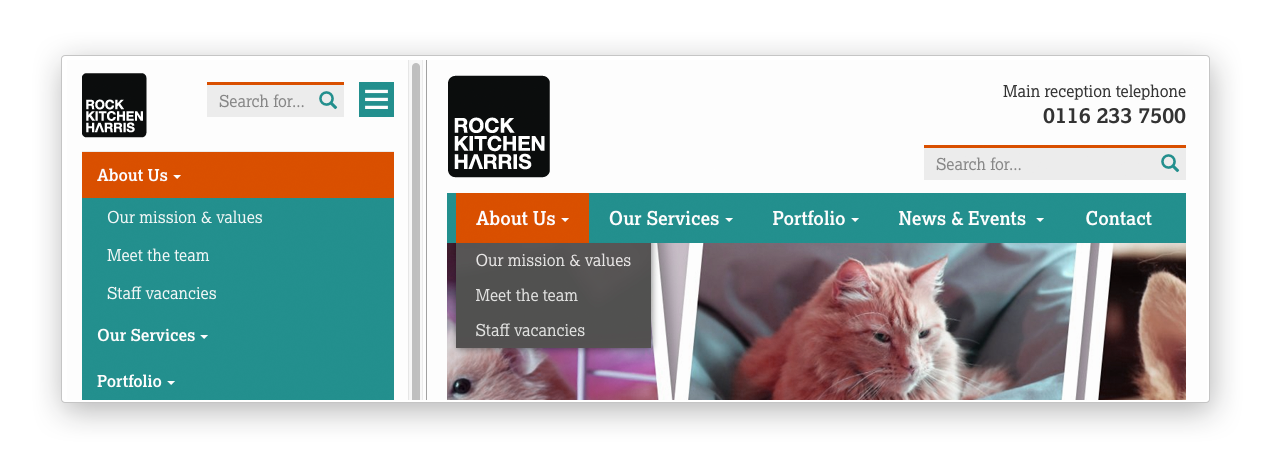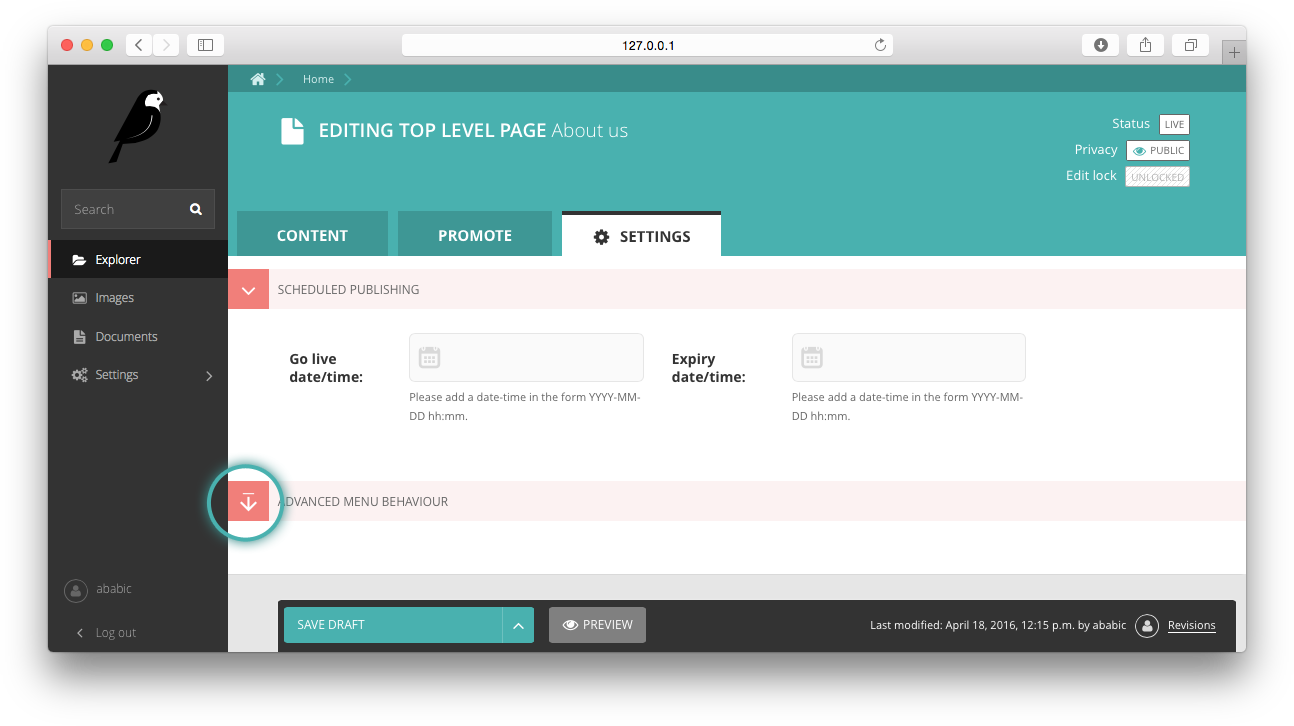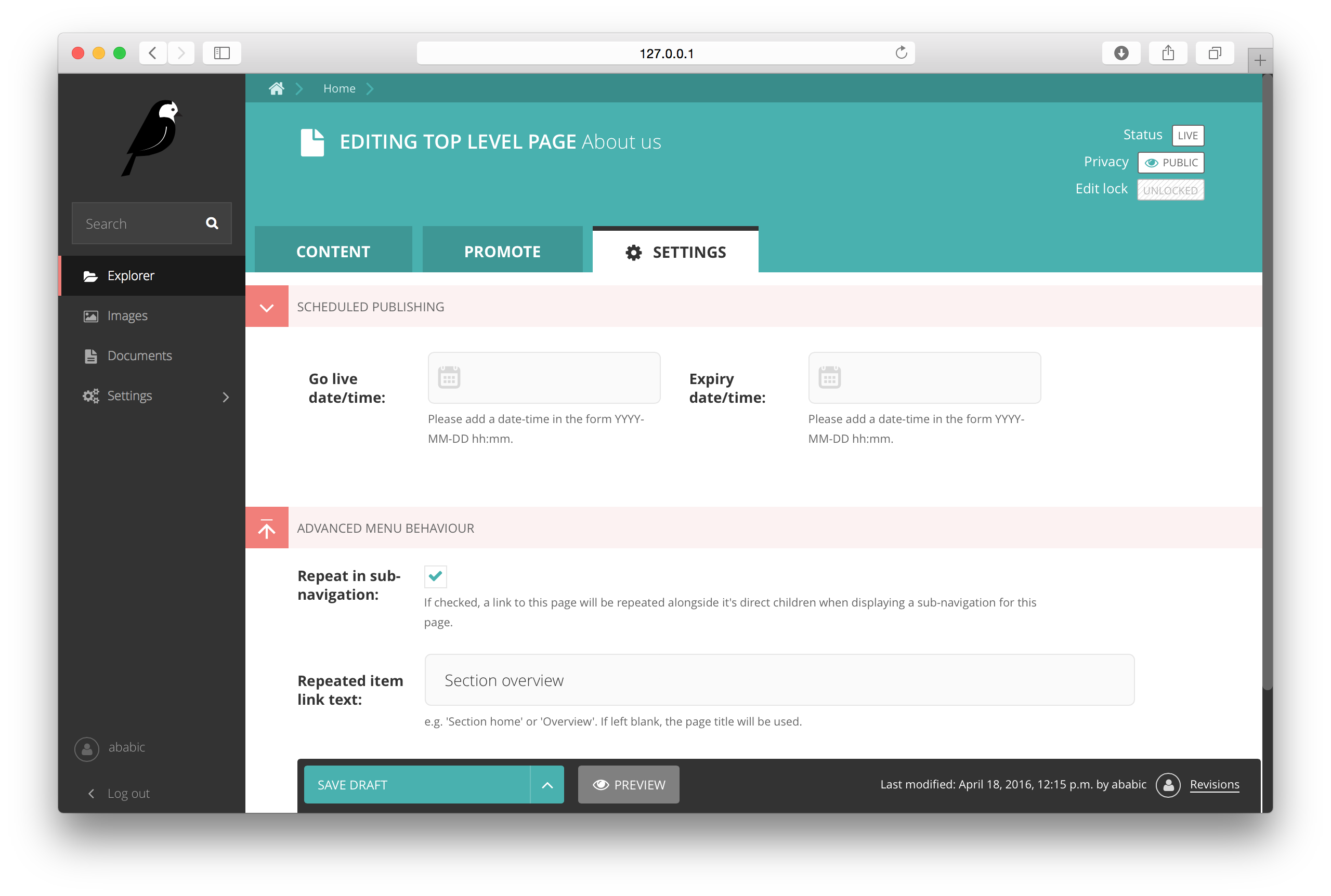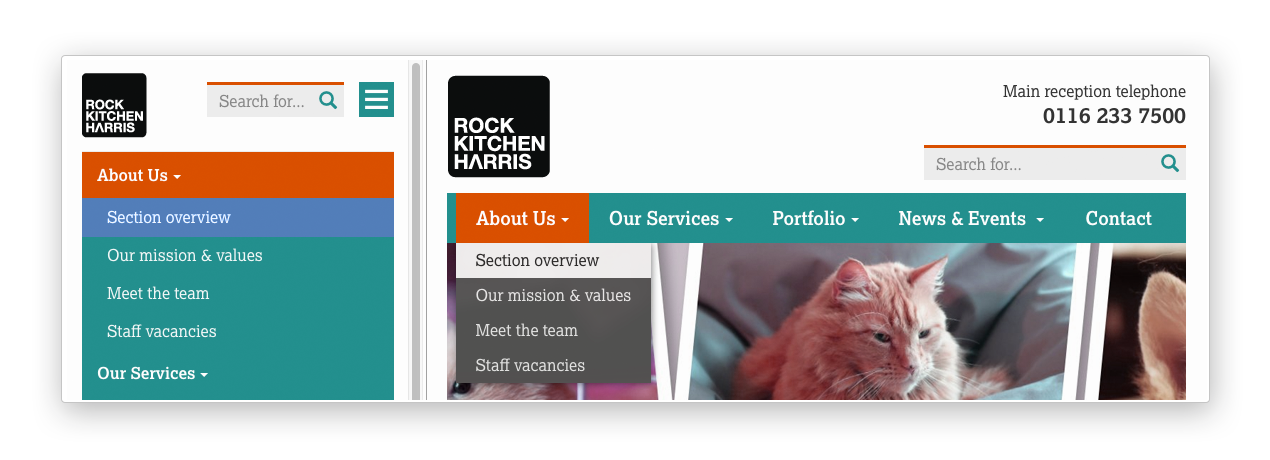The MenuPage and MenuPageMixin models¶
The MenuPageMixin and MenuPage models were created specifically to solve the problem of important page links becoming merely toggles in multi-level menus, preventing users from accessing them easily.
A typical scenario¶
Let’s say you have an About Us section on your site. The top-level “About Us” page has content on it that is just as important as it’s children (e.g. “Meet the team”, “Our mission and values”, “Staff vacancies”). Because of this, you’d like visitors to be able to access the root page as easily as those pages. But, your site uses some form of collapsible multi-level navigation, and the About Us page link has become merely a toggle for hiding and showing its sub-pages, making it difficult to get to directly:

MenuPage to the rescue!¶
If the About Us page uses a model that subclasses MenuPage or MenuPageMixin, you can solve this issue by doing the following:
Edit the page via the CMS, and click on the “Settings” tab.
Uncollapse the “ADVANCED MENU BEHAVIOUR” panel by clicking the downward-pointing arrow next to the panel’s label

Tick the Repeat in sub-navigation checkbox that appears, and publish your changes.

Now, wherever the children of the About Us page are output (using one of the above menu tags), an additional link will appear alongside them, allowing that page to be accessed more easily. In the example above, you’ll see “Section overview” has been added to the Repeated item link text field. With this set, the link text for the repeated item should read “Section overview”, instead of just repeating the page’s title, like so:

The menu tags do some extra work to ensure both links are never assigned the ‘active’ class. When on the ‘About Us’ page, the tags will treat the repeated item as the ‘active’ page, and just assign the ‘ancestor’ class to the original, so that the styling is consistent with other page links rendered at that level.
Implementing MenuPage into your project¶
Subclass
wagtailmenus.models.MenuPageon your model instead of the usualwagtail.wagtacore.models.Page, just like in the following example:# appname/models.py from wagtailmenus.models import MenuPage class GenericPage(MenuPage): """ This model will gain the fields, methods and 'setting_panels' attribute from MenuPage. """ ...
Or, if you’re using an abstract ‘base’ model in you project to improve consistency of common functionality, you could update the base model, like so:
# appname/models.py from wagtailmenus.models import MenuPage class BaseProjectPage(MenuPage): ... class GenericPage(BaseProjectPage): ... class ContactPage(BaseProjectPage): ...
If you’re not overriding the
settings_panelsattribute on any of the models involved, you can skip this step. But, if you are overriding thesettings_panelsattribute on a custom model to surface other custom fields in that tab, you’ll need to include additional panels to surface the newMenuPagefields in the page editor interface. Wagtailmenus includes a pre-definedmenupage_panelto make this easier, which you can use like this:# appname/models.py from wagtailmenus.models import MenuPage from wagtailmenus.panels import menupage_panel class GenericPage(MenuPage): """ This model will gain the fields, methods and `setting_panels` attribute from `MenuPage`, but `settings_panels` is being overridden to include other fields in the `Settings` tab. """ custom_settings_field_one = BooleanField(default=False) custom_settings_field_two = BooleanField(default=True) # `menupage_settings_panels` is a collapsible `MultiFieldPanel` with the important # fields already grouped together in addition to wagtail settings fields, making # it easy to include in custom panel definitions as shown. If you want to exclude # wagtail settings, instead use `[menupage_panel]` settings_panels = [ FieldPanel('custom_settings_field_one'), FieldPanel('custom_settings_field_two'), ] + menupage_settings_panels ...
Create migrations for any models you’ve updated by running:
python manage.py makemigrations appnameApply the new migrations by running:
python manage.py migrate appname
Implementing MenuPageMixin into your project¶
Wagtail has a restriction that forbids models from subclassing more than one other class derived from Page, and that single page-derived class must be the left-most item when subclassing more than one model class. Most of the time, that doesn’t cause any noticeable issues. But, in some cases, it can make it difficult to swap out base model classes used for page models. In these cases, you can use wagtailmenus.models.MenuPageMixin instead of MenuPage.
Note
MenuPageMixin doesn’t change make any changes to the panel configuration on your model that would cause it’s new fields to be surfaced in the page editing interface. If you want those fields to appear, you’ll have to override settings_panels on your model to include menupage_panel. If you want to retain wagtails settings fields for features like comments, privacy, and scheduled publishing, add menupage_settings_panels.
Subclass
wagtailmenus.models.MenuPageMixinto create your model, including it to the right of any other class that subclassesPage:
# appname/models.py from wagtail.contrib.forms.models import AbstractEmailForm from wagtailmenus.models import MenuPageMixin # option 1 (described below) from wagtailmenus.panels import menupage_panel # option 2 (described below) from wagtailmenus.panels import menupage_settings_panels class MyEmailFormPage(AbstractEmailForm, MenuPageMixin): """This page will gain the same fields and methods as if it extended `wagtailmenus.models.MenuPage`""" ... # It's not possible for MenuPageMixin to set `settings_panel`, so you must # override `settings_panels` yourself, and include `menupage_panel` or # `menupage_settings_panels` in order to surface additional fields in # the 'Settings' tab of the editor interface # If you wish to retain the wagtail `settings_panel` features like privacy, # comments, etc, you must include Page.settings_panels # option 1 # this version simply retains wagtail and wagtailmenus settings # this is what the MenuPage class uses by default settings_panels = menupage_settings_panels # option 2 # this version drops wagail settings and adds custom ones in # addition to wagtailmenus fields settings_panels = [ FieldPanel('custom_settings_field_one'), FieldPanel('custom_settings_field_two'), menupage_panel ] ...
Create migrations for any models you’ve updated by running:
python manage.py makemigrations appname
Apply the new migrations by running:
python manage.py migrate appname
Using MenuPage to manipulate sub-menu items¶
When a page model subclasses MenuPage or MenuPageMixin, pages of that type are given special treatment by the menu generation template tags included in wagtailmenus, allowing them to make changes to the sub-menu items that get rendered below them.
The functionality exists to allow MenuPage pages to add repeating links to themselves into a sub-menu, but can be extended to meet any custom needs you might have.
For example, if you had a ContactPage model, and in main menus, you wanted to add some additional links below each ContactPage, you could achieve that by overriding the modify_submenu_items() and has_submenu_items() methods like so:
# appname/models.py
from wagtailmenus.models import MenuPage
class ContactPage(MenuPage):
...
current_page, current_ancestor_ids,
current_site, allow_repeating_parents, apply_active_classes,
original_menu_tag, menu_instance, request, use_absolute_page_urls
def modify_submenu_items(self, menu_items, **kwargs):
"""
If rendering a 'main_menu', add some additional menu items to the end
of the list that link to various anchored sections on the same page.
We're only making use 'original_menu_tag' and 'current_site' in this
example, but `kwargs` should have all of the following keys:
* 'current_page'
* 'current_ancestor_ids'
* 'current_site'
* 'allow_repeating_parents'
* 'apply_active_classes'
* 'original_menu_tag'
* 'menu_instance'
* 'request'
* 'use_absolute_page_urls'
"""
# Start by applying default modifications
menu_items = super(ContactPage, self).modify_submenu_items(menu_items, **kwargs)
if kwargs['original_menu_tag'] == 'main_menu':
base_url = self.relative_url(kwargs['current_site'])
"""
Additional menu items can be objects with the necessary attributes,
or simple dictionaries. `href` is used for the link URL, and `text`
is the text displayed for each link. Below, I've also used
`active_class` to add some additional CSS classes to these items,
so that I can target them with additional CSS
"""
menu_items.extend((
{
'text': 'Get support',
'href': base_url + '#support',
'active_class': 'support',
},
{
'text': 'Speak to someone',
'href': base_url + '#call',
'active_class': 'call',
},
{
'text': 'Map & directions',
'href': base_url + '#map',
'active_class': 'map',
},
))
return menu_items
def has_submenu_items(self, **kwargs):
"""
Because `modify_submenu_items` is being used to add additional menu
items, we need to indicate in menu templates that `ContactPage` objects
do have submenu items in main menus, even if they don't have children
pages.
We're only making use 'original_menu_tag' in this example, but
`kwargs` should have all of the following keys:
* 'current_page'
* 'allow_repeating_parents'
* 'original_menu_tag'
* 'menu_instance'
* 'request'
"""
if kwargs['original_menu_tag'] == 'main_menu':
return True
# Resort to default behaviour
return super(ContactPage, self).has_submenu_items(**kwargs)
The above changes would result in the following HTML output when rendering a ContactPage instance in a main menu:
...
<li class=" dropdown">
<a href="/contact-us/" class="dropdown-toggle" id="ddtoggle_18" data-toggle="dropdown" aria-haspopup="true" aria-expanded="false">Contact us <span class="caret"></span></a>
<ul class="dropdown-menu" aria-labelledby="ddtoggle_18">
<li class="support"><a href="/contact-us/#support">Get support</a></li>
<li class="call"><a href="/contact-us/#call">Speak to someone</a></li>
<li class="map"><a href="/contact-us/#map">Map & directions</a></li>
</ul>
</li>
...
You can also modify sub-menu items based on field values for specific instances, rather than doing the same for every page of the same type. Here’s another example:
# appname/models.py
from django.db import models
from wagtailmenus.models import MenuPage
class SectionRootPage(MenuPage):
add_submenu_item_for_news = models.BooleanField(default=False)
def modify_submenu_items(
self, menu_items, current_page, current_ancestor_ids, current_site,
allow_repeating_parents, apply_active_classes, original_menu_tag='',
menu_instance, request, use_absolute_page_urls
):
menu_items = super(SectionRootPage,self).modify_menu_items(
menu_items, current_page, current_ancestor_ids,
current_site, allow_repeating_parents, apply_active_classes,
original_menu_tag, menu_instance, request, use_absolute_page_urls)
if self.add_submenu_item_for_news:
menu_items.append({
'href': '/news/',
'text': 'Read the news',
'active_class': 'news-link',
})
return menu_items
def has_submenu_items(
self, current_page, allow_repeating_parents, original_menu_tag,
menu_instance, request
):
if self.add_submenu_item_for_news:
return True
return super(SectionRootPage, self).has_submenu_items(
current_page, allow_repeating_parents, original_menu_tag,
menu_instance, request)
Note
If you’re overriding modify_submenu_items(), please ensure that ‘repeated menu items’ are still added as the first item in the returned menu_items list. If not, active class highlighting might not work as expected.